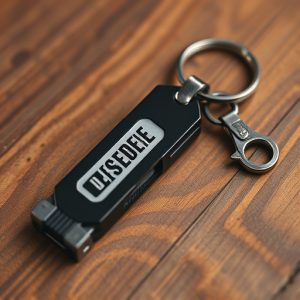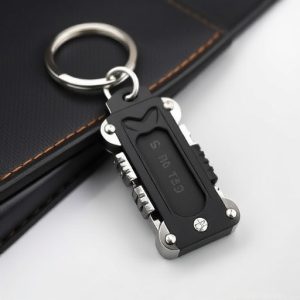Metal Keychain Grip Design: Tips for Discreet Self-Defense Tools
Choosing the right metal is crucial for crafting durable and discreet keychain protection tools. Mat…….
Choosing the right metal is crucial for crafting durable and discreet keychain protection tools. Materials like stainless steel, titanium, or aluminum offer a balance of strength, lightness, and corrosion resistance, enhancing both functionality and aesthetics. These metals enable precise designs for secure gripping and easy portability, catering to diverse user needs from everyday carry to outdoor adventures and professional use. Ergonomic features ensure comfort during use, appealing to self-defense enthusiasts and those seeking practical tools that seamlessly merge form and function.
In today’s world, discreet keychain protection tools are essential for personal safety and peace of mind. This comprehensive guide delves into the art of designing metal defense keychains, focusing on both functionality and discretion. We explore material choices, from sturdy stainless steel to lightweight titanium, weighing strength against visual impact. Learn about ergonomic designs that offer a comfortable grip without sacrificing compactness. Discover subtle yet powerful security features, such as locking mechanisms and hidden compartments, ensuring your keys remain secure. Plus, discover how esthetic appeal and customization can transform these tools into stylish accessories.
- Choosing the Right Metal for Discreet Keychain Defense
- – Discussing the importance of material selection for both strength and minimal visual impact
- – Comparing popular metals like stainless steel, aluminum, and titanium
- Designing for Ergonomics and Ease of Use
Choosing the Right Metal for Discreet Keychain Defense
When designing a discreet keychain defense, selecting the appropriate metal is key. The right metal can enhance functionality and ensure your keychain protection tools are both sturdy and lightweight. Look for metals that offer excellent strength-to-weight ratio like stainless steel or titanium. These materials are resistant to corrosion, ensuring your defensive accessory lasts long through various weather conditions.
Opting for these high-quality metals also allows for more intricate designs without sacrificing durability. The ability to machine precise cuts and patterns ensures a secure grip and easy portability, making them ideal choices for discreet keychain protection tools.
– Discussing the importance of material selection for both strength and minimal visual impact
When designing a metal defense keychain, material selection is paramount. The chosen elements must offer robust strength and durability to ensure it can withstand daily wear and potential impact, while also maintaining a sleek, discreet design for its intended purpose as subtle protection tools. Opting for high-quality metals like stainless steel or titanium not only bolsters structural integrity but also minimizes visual bulk, preserving the keychain’s overall aesthetic appeal.
A smart material choice allows for the creation of thin yet sturdy components, enabling designers to achieve both strength and minimalism. This balance is crucial for a discreet keychain protection tool that can easily fit into pockets or attach to bags without drawing unwanted attention. The end result should be a functional accessory that seamlessly blends form with function, providing peace of mind without sacrificing style.
– Comparing popular metals like stainless steel, aluminum, and titanium
When it comes to choosing metals for a discreet keychain protection tool, several options stand out due to their unique properties and popularity among users. Stainless steel is a common choice for its durability and corrosion resistance, making it suitable for everyday carry tools that might see some wear and tear. It offers excellent strength-to-weight ratio, ensuring the keychain remains sturdy without adding significant bulk.
Aluminum, on the other hand, is known for its lightweight nature, providing superior portability without compromising strength. This metal is highly resistant to corrosion, making it ideal for outdoor enthusiasts or those living in humid environments. Titanium also garners attention for its exceptional strength-to-weight ratio and durability, often favored by professionals who need reliable tools in challenging conditions. Each metal offers distinct advantages, catering to different user preferences and needs for discreet keychain protection tools.
Designing for Ergonomics and Ease of Use
When designing a metal defense keychain, prioritizing ergonomics and ease of use is paramount. The keychain should fit comfortably in the user’s hand, allowing for secure and effortless grip. Consider the overall shape and size, ensuring it’s not too bulky or awkward to handle. A well-designed keychain should seamlessly integrate discreet protection tools like a small pocket knife, flashlight, or self-defense tool, without sacrificing comfort during everyday use. The key chain’s weight distribution and balance play a crucial role in its functionality; it must be balanced enough to prevent slipping or causing strain when attached to a bag or belt.
Ergonomic designs also take into account the user’s grip style and hand size variations. Incorporating adjustable features, such as interchangeable grips or customizable cord attachments, ensures that anyone can use the keychain comfortably. These subtle yet effective adjustments make metal defense keychains not just practical self-defense tools but also reliable companions for everyday carry enthusiasts seeking discreet keychain protection tools.
When crafting a discreet keychain defense tool, the right metal and thoughtful design go hand in hand. By selecting robust yet lightweight materials like stainless steel, aluminum, or titanium, you ensure both strength and minimal visual impact. Combining this with an ergonomic grip and easy-to-use mechanism creates a powerful and subtle self-defense option. Incorporating these design tips will result in effective discreet keychain protection tools that offer peace of mind without drawing unnecessary attention.


